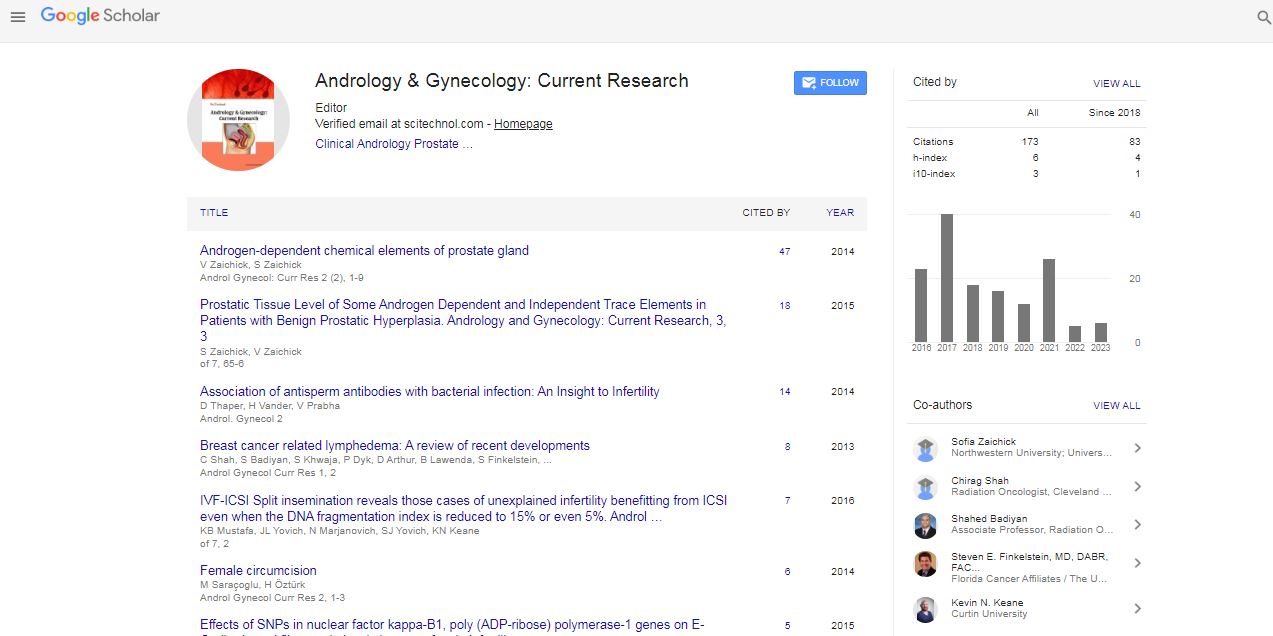Editorial, Androl Gynecol Curr Res Vol: 13 Issue: 1
Endometriosis: Pathophysiology and Novel Therapeutic Approaches
Harlev S*
Department of Pathophysiology and Novel Therapeutic Approaches, Netherlands
- *Corresponding Author:
- Harlev S
Department of Pathophysiology and Novel Therapeutic Approaches, Netherlands
E-mail: Harlev_s@gmail.com
Received: 07-Jan-2025, Manuscript No. AGCR-25-168376, Editor assigned: 08-March-2025, PreQC No. AGCR-25-168376 (PQ), Reviewed: 15-March-2025, QC No. AGCR-25-168376, Revised: 22-March-2025, Manuscript No. AGCR-25-168376 (R), Published: 28-March-2025, DOI:10.4172/2327-4360.1000349
Citation: Harlev S (2025) Endometriosis: Pathophysiology and Novel Therapeutic Approaches. Andre Gyn Curr Res 13:1.
Copyright: © Received: 07-Jan-2025, Manuscript No. AGCR-25-168376, Editor assigned: 08-March-2025, PreQC No. AGCR-25-168376 (PQ), Reviewed: 15-March-2025, QC No. AGCR-25-168376, Revised: 22-March-2025, Manuscript No. AGCR-25-168376 (R), Published: 28-March-2025, DOI:10.4172/2327-4360.1000349
Abstract
Introduction
Endometriosis is a chronic gynaecological condition affecting approximately 10% of women of reproductive age. It is characterized by the presence of endometrial-like tissue outside the uterine cavity, most commonly on the ovaries, pelvic peritoneum, and rectovaginal septum. The disorder causes pelvic pain, dysmenorrhea, and infertility, significantly impairing quality of life. Despite extensive research, the precise pathophysiology remains incompletely understood, and current treatments are often limited by side effects and recurrence. This editorial aims to synthesize current understanding of endometriosis pathophysiology and highlight emerging therapeutic strategies [1]-3].
Pathophysiology Overview
Endometriosis is a multifactorial disease involving genetic, immunological, hormonal, and environmental factors. The most widely accepted theory is retrograde menstruation, wherein viable endometrial cells reflux through the fallopian tubes into the peritoneal cavity, implant, and proliferate. However, this theory does not fully explain the disease, especially in distant locations.
- Genetic and Epigenetic Factors
Genetic predisposition plays a role, with several susceptibility loci identified via genome-wide association studies (GWAS). Epigenetic modifications, including DNA methylation and histone acetylation, influence gene expression in ectopic endometrial cells, contributing to altered cell proliferation and inflammation.
- Immune Dysregulation
Endometriosis is associated with aberrant immune responses, including impaired clearance of ectopic cells and increased pro-inflammatory cytokines. Macrophages and natural killer (NK) cells exhibit altered function, promoting lesion survival and angiogenesis.
- Hormonal Influences
Estrogen dependence is central to endometriosis pathophysiology. Ectopic lesions locally produce estrogen through aromatase activity, driving proliferation and inflammation. Progesterone resistance is also observed, diminishing the anti-proliferative effects of progesterone.
Novel Therapeutic Approaches
- Hormonal Therapies Targeting Estrogen Pathways
Current treatments largely focus on suppressing ovarian estrogen production using combined oral contraceptives, GnRH agonists/antagonists, and progestins. Recently, aromatase inhibitors have emerged as adjuncts to block local estrogen synthesis within lesions.
- Immunomodulatory Therapies
Given the immune dysfunction, therapies aiming to restore immune balance are under investigation. Agents targeting cytokines (e.g., TNF-α) and macrophage function show promise in preclinical studies but require further clinical validation [4], 5].
- Epigenetic Modifiers
Epigenetic therapies, including histone deacetylase inhibitors and DNA methyltransferase inhibitors, are being explored to reverse aberrant gene expression patterns in endometriotic tissue.
- Targeted Molecular Therapies
Novel agents targeting angiogenesis (e.g., VEGF inhibitors), nerve growth factors (to reduce pain), and cell proliferation pathways (e.g., mTOR inhibitors) offer new avenues for disease management.
- Minimally Invasive Surgery and Adjunct Treatments
Laparoscopic excision remains a cornerstone for symptomatic lesions, especially in infertility. Advances in surgical techniques and adjunct therapies, such as intraoperative hormone therapy, aim to reduce recurrence.
Challenges and Future Directions
The heterogeneity of endometriosis complicates treatment, necessitating personalized approaches. Biomarkers for early diagnosis and treatment response monitoring are urgently needed. Multimodal strategies combining hormonal, immunological, and surgical treatments hold promise for improved outcomes.
Conclusion
Endometriosis remains a challenging condition due to its complex pathophysiology and variable clinical presentation. Recent advances in understanding the molecular and immunological mechanisms have paved the way for novel targeted therapies beyond traditional hormonal suppression. Continued research is essential to develop safer, more effective, and individualized treatments to enhance the quality of life for women affected by this debilitating disease.
References
- Mujagic S, Kozic D, Huseinagic H, Smajlovic D. Symmetry, asymmetry and hypoplasia of intracranial internal carotid artery on magnetic resonance angiography. Acta Med Acad. 2016; 45:1- 9.
- Rusu MC, Vrapclu AD, Lazar M. A rare variant of accessory cerebral artery. Surg Radiol Anat. 2023; 45(5):523-526.
- Krause DA, Youdas JW. Bilateral presence of a variant subscapularis muscle. Int J Anat Var. 2017; 10(4):79-80.
- Mann MR, Plutecki D, Janda P, PÄ?kala J, Malinowski K, et al. The subscapularis muscleâ?a metaâ?analysis of its variations, prevalence, and anatomy.â?¯ Clin Anat. 2023; 36(3):527-541.
- Pillay M, Jacob SM. Bilateral presence of axillary arch muscle passing through the posterior cord of the brachial plexus. Int. J. Morphol., 27(4):1047-1050, 2009.
 Spanish
Spanish  Chinese
Chinese  Russian
Russian  German
German  French
French  Japanese
Japanese  Portuguese
Portuguese  Hindi
Hindi 


